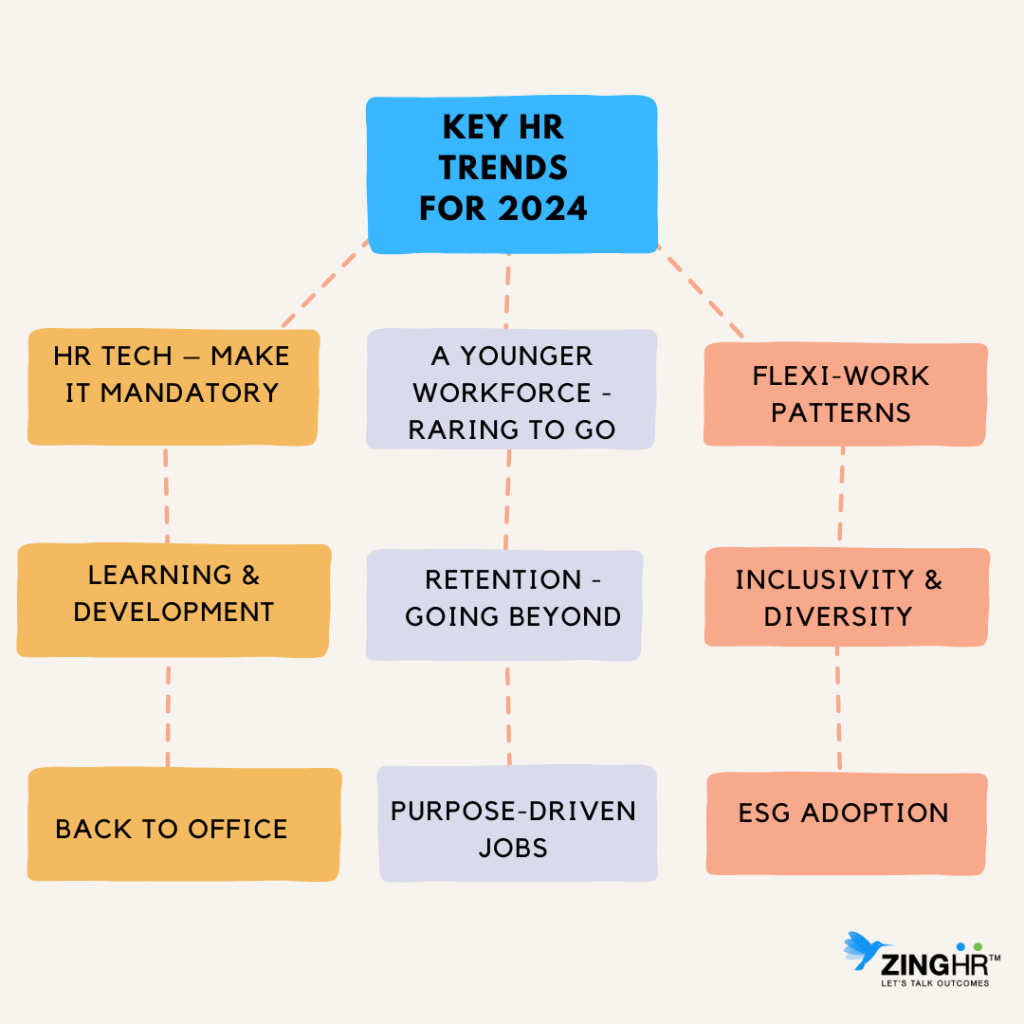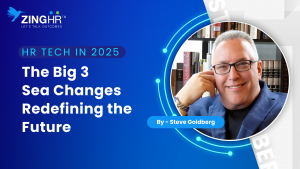Looking Back:
2023 may be defined as the year of ‘Re-Learning’. Having witnessed never-before transformations between 2020 and 2022, organisations had to adapt to fit in. The onus of a seamless transition fell upon the management, who in turn had to seek guidance from the Human Resource departments. After all, in the organisational system, the HR personnel were the ones closest to employees. To combat the new challenges of 2023, Human Resources had to evolve.
1. HR dons a New Identity
As the organisational landscape matured, Human Resources had no choice but to keep up with the pace. With management also now approaching them, their responsibilities grew by leaps and bounds. It was their time to be ‘Heard’! Studies have shown that:
83% of HR leaders say they are expected to do more as compared to three years ago. (Source: gartner.com)
74% of HR leaders report that their organisations rely more heavily on them. (Source: Linkedin)
58% say they have more authority to determine organisational priorities. (Source: gartner.com)
70% of HR leaders say they have more opportunities for impact. (Source: gartner.com)

2. Innovation – the only way forward
Hybrid work environments, taking a stand on social issues were just some of the challenges being faced by the Human Resources. To emerge non-scathed, ‘Innovation’ was the immediate answer. Fresh concepts, strategies, procedures and prudent use of technology had to be brought in. It became imperative to go beyond being ‘responsive’ to silo situations. An all-inclusive approach had to be considered while keeping in mind future needs and situations. From developing partnerships, managing stakeholder expectations, and doing away with negative incentives, the HR departments had a lot on their plate. Making innovation a core value became crucial.
3. Technology – Adopt or Go Obsolete
With GenAI taking over our lives, HR professionals are being approached for their opinions on technology trends. To be able to prudently assess new technological trends, it is important for HR leaders to have a structured approach. A sense of FOMO (Fear of Missing Out) seems to have gripped most CHROs, who are now keen on befriending tech, and are getting actively involved in decision making vis-à-vis technology. The learning curves of HR professionals demonstrated an upward trend. 76% of HR leaders agree that they will be lagging in organizational success, if they do not adopt and implement GenerativeAI in the next few months. (Source: unleash.ai)
4. Hybrid Work Model – here to stay?
The Covid years redefined work culture, compelling organizations to look at a work-from-home structure. Businesses had to go on, and this was the only plausible way of facilitating it. As the Covid threat mitigated, most organisations asked their employees to return to offices. But this did not go down well with people who had now become comfortable working from the confines of their homes, offering them flexibility. To counter this and also to retain talent, organizations came up with the Hybrid Work Model, which required staff members to come into office two or three times a week, while continuing to work from home on the other days. Hybrid working is now the ‘new normal’.
5. Industrial Relations – in a new Avataar
The concept of ‘industrial unions’ is fast dwindling. The responsibility of ‘employee relations’ now lies with the HR Management. Based on a set of rules and processes, they include functions that serve as the interface between management and employees.Analysts arrive at solutions to conflicts by analyzing employment issues. The process is based on the four pillars: Respect, Equality, Safety and Trust.
6. Gig Economy & Freelancing – Nothing Permanent?
Remote Working is believed to have been the genesis of a Gig Economy. Today, a freelancer can take up a job or a project whilst being located anywhere in the world. Organizations too have the choice of selecting the person they deem best for the job. Convenience, cost and quality of service, seem to be the current deal makers/breakers. By not being ‘tied’ to the service provider, organisations save on money and resources. Employee benefits, insurance, providing office space and equipment, training are just some of the toppings that are no longer the organization’s responsibility.
7. Employee Wellness – a Force to Reckon With
‘The 2023 Fortune 100 Best Companies to Work For’ enlisted Employee well-being as one of the biggest differentiators for companies. Having a psychologically and emotionally healthy workplace translated to offering a robust and holistic employee experience, which correlates directly with an organization’s ability to thrive in a recession.
According to a survey released by a global consultancy, the UAE ranks among the top countries for employee well-being, higher than the global average and many developed countries.
8. Employee Experience – a Boardroom Priority
The Employee Experience concept has come a long way. A decade ago, organizations were concerned with only the bottom line. Today, especially post- Covid, priorities have shifted. Starting with the hiring process right up to the exit interview, the company values an employee’s feelings and perception. Organizations are keen on retaining top talents, especially in a competitive world. After all, a happily engaged person at work is also more productive, innovative and looks forward to staying in the organization longer. In fact, even Government employees and PSUs are prioritizing employee experience by investing heavily in HR technology. Tools such as digital health apps, wearable devices, diagnostics and absence management systems have revolutionised the way organizations protect and support employee wellness.
9. Going Beyond Salary – Making it Meaningful
The current tribe of employees is seeking ‘purpose-driven’ jobs. Salaries and Perks are important, but engaging in ‘meaningful’ activities adds an extra sheen. The need to retain talent and help employees use specific skills for the greater good now compels HR professionals to offer such opportunities. Studies have shown that by doing so, the overall productivity levels have increased.
10. HR Management – Tangible Gratification
While processes such as recruiting, hiring, compensating, retaining, and motivating are indispensable, one factor that boosts job satisfaction and enhances performance is ‘Training’. Imbibing new knowledge and upgrading skills is a thirst innate in most employees. HR Professionals have recognised this ‘need’ and provide suitable programs and platforms for employees to ‘learn & grow’.
Racing Forward:
If 2023 was a year of ‘Re-Learning’, 2024 will most likely be a year of ‘Strengthening those Learnings’. Having discovered multiple routes to alleviate challenges, and finding the best ones by trial and error, HR professionals are now better equipped to move ahead. The areas that might need a closer look are:
1. HR Tech – Make it Mandatory
A structured onboarding program is the way forward to retain freshly hired workforce. Thanks to AI, there is a plethora of employee management software programs available. The HR professionals may study and adopt the best suited for their organizations. New entrants consider the programs that go beyond paperwork and processes most professional.
2. A younger workforce – Raring to go
A workforce comprising a mix of Millennials and Gen Z comes with personal agendas. Clear career growth opportunities in the shortest possible time are the most popular goals. Thus, the onus is on the organization’s HR professionals to recognize their skill sets, and tailor-make them to suit organisational goals.
3. Flexi work patterns – for a better work-life balance
‘Work hard; Party harder’ is the current generation’s mantra. They do not shy away from putting in laborious hours, but what they demand is their ‘Me time’. ‘Four-day week’ pilot projects in Great Britain have received a resounding welcome. There has not only been a spike in revenue but also a substantial increase in workplace productivity levels. HR professionals across the globe will now have to be ready with their own versions to embrace this new concept.
4. Learning & Development – War for Skills to Stay alive
It will become extremely important for HR leaders to anticipate upcoming disruptions, identify skill sets that will become irrelevant and plan for upskilling/reskilling employees that are likely to be relevant. A good HR Tech platform can help HR leaders not only identify these opportunities but plan, roll out reskilling initiatives and measure the readiness of their workforce to not just survive but thrive in this era of disruptions. A select few Enterprise HR Tech platforms like ZingHR not only help employees themselves discover their own career paths within the organisation but also identify the skill sets needed and how they can acquire these skills with the help of their HR business partners.
5. Retention – Going Beyond
Employers retain talent at the workplace by creating a perfect blend of employee wellness programs and recognition. Every person is thirsty for acknowledgement when they do a job right. Rewards that include a certificate of appreciation or a mention in the newsletter can go a long way in boosting one’s commitment to an organization.
6. Inclusivity & Diversity – Job suitability, the only criteria
Times have changed. Gender, Religion, Language, Socio-economic status, Sexual orientation are being relegated to the back burner during the talent hiring process. The most important qualifier is ‘Job suitability’. What matters are: Is the person a good fit for the position? Can we groom this person for growth and success? Does this person’s integrity shine? Are this person’s goals in alignment with the organization’s vision?
7. Back to Office – Will it Succeed or Backfire?
There is an on-going debate over this. According to a study, 90% of organizations plan to end the remote working concept. They argue that a lack of collaboration and employee engagement has led to a dip in productivity levels. While 30% organizations are ready to fire employees who refuse to comply with in-office requirements, there is a significant number that’s ready to give up their jobs if flexibility is not offered. Perhaps it is time for HR professionals to consider a two-three days per week attendance, to establish a hybrid model.
8. A Sense of Purpose – Legacy matters
As discovered in 2023, ‘Purpose-driven jobs’ are here to stay. Today’s workforce puts a lot of emphasis on what they wish to achieve ultimately or the legacy they wish to leave behind. Working towards a greater good by identifying something meaningful, can actually make a person experience greater career satisfaction. An organisation that recognises this need and takes a step forward by offering suitable opportunities to ‘give back’, would rank high on a list of ‘good places to work at’.
9. HR Leaders – the flag bearers of ESG adoption
In 2024, there will be a growing push towards establishing universal metrics and reporting frameworks for ESG practices. This trend will involve efforts to create a standardized system for measuring and disclosing environmental, social, and governance factors across industries and regions. Establishing common ESG metrics will enable better comparability, reliability, and transparency in assessing companies’ sustainability efforts. This move toward standardization will aim to provide clearer insights for investors, stakeholders, and consumers, ultimately driving more informed decision-making and accountability regarding ESG performance.
HR leaders will have the ability to embed the sustainability practices onto the DNA of the organisational culture. They will be the driving force in achieving organisational goals vide ESG goals.




